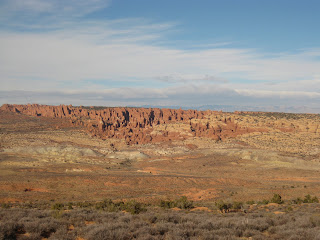This month's question comes from Ann and her musings. She asks what about the geology of home do you love or perhaps not like. This was an easy one! Back in 2000 when the world seemed lighter and fresher and open to all manners of imagination, we moved ourselves from perfectly good jobs to the western part of Colorado just to be near the canyons and mountains. I won't go into how the education job market has been in a steady decline since 2001, but I will talk about the geology.
How can you not love the San Juan Mountains of Colorado? Just in a single glance we can see sediment deposited in ancient seaways and ancient deserts, intense mountain building with its accompanied faults and folds and the topped off with all sorts of volcanic evidence from lava flows and ash deposits to hydrothermal mineral deposits then the whole mix was well glaciated just a short time ago. My only compliant is that the area is so complex that my small mind has trouble wrapping around some of the views. I keep saying that the rocks tell a story, well this story is a bit complex.
The story doesn't end there. Just a short distance west is the Colorado Plateau. A fantastic playground full of red rock canyons, fast flowing desert rivers and evidence of previous occupants in the form of ruins and rock art. I have been so fortunate to spend the last 9 summers teaching K-12 teachers about geology while canoeing down some of the west's most iconic rivers, often in the footsteps (or paddle strokes) of John Wesley Powell. We explore pre-Cambrian rock units in some of the rapids we negotiate. We have a campsite on a 1.5 billion year unconformity. Students can observe the difference between sandstone deposited by water and sandstone deposited by wind. Then, at the end, we play particles ourselves and float towards the Pacific Ocean. What an awesome place.
A high country lake near Silverton Colorado
 Red Mountain #2, taken from Red Mountain #1 on the edge of the Silverton caldera. Obviously a heavily mineralized area with not-so-original names.
Red Mountain #2, taken from Red Mountain #1 on the edge of the Silverton caldera. Obviously a heavily mineralized area with not-so-original names. An arch found in the Cedar Mesa formation
An arch found in the Cedar Mesa formation That's me on top of Bow Knot bend, named by Powell as the Green River flows 7 miles to travel 600 yards through a very tight entrenched meander.
That's me on top of Bow Knot bend, named by Powell as the Green River flows 7 miles to travel 600 yards through a very tight entrenched meander. Entering spilt mountain in Dinosaur NM on the Green River
Entering spilt mountain in Dinosaur NM on the Green River







